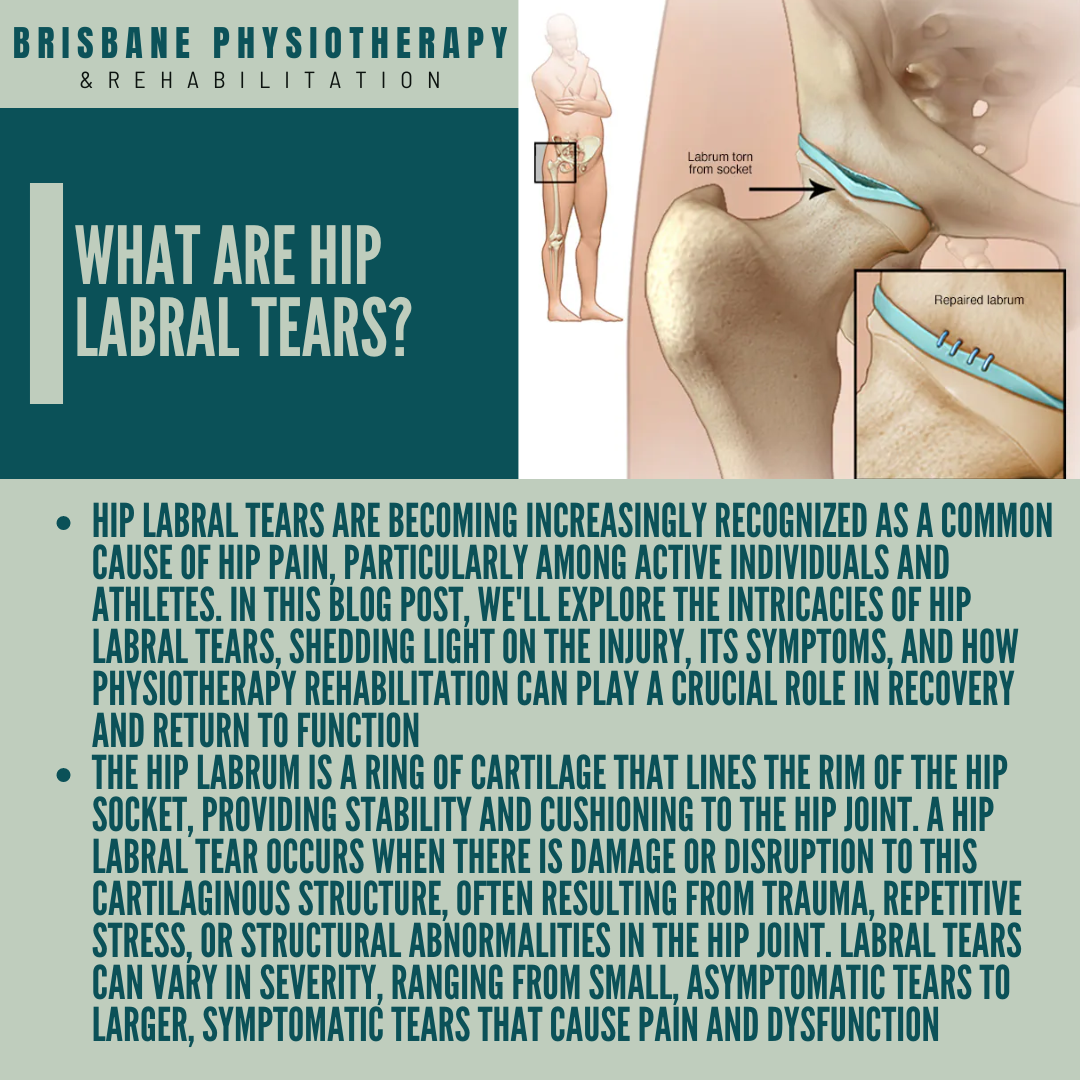What are Hip Labral Tears?
Introduction:
Hip labral tears are becoming increasingly recognized as a common cause of hip pain, particularly among active individuals and athletes. In this blog post, we'll explore the intricacies of hip labral tears, shedding light on the injury, its symptoms, and how physiotherapy rehabilitation can play a crucial role in recovery and return to function.
Understanding Hip Labral Tears:
The hip labrum is a ring of cartilage that lines the rim of the hip socket, providing stability and cushioning to the hip joint. A hip labral tear occurs when there is damage or disruption to this cartilaginous structure, often resulting from trauma, repetitive stress, or structural abnormalities in the hip joint. Labral tears can vary in severity, ranging from small, asymptomatic tears to larger, symptomatic tears that cause pain and dysfunction.
Causes of Hip Labral Tears:
Several factors can contribute to the development of hip labral tears, including:
Trauma: Direct impact to the hip joint, such as a fall or sports-related injury, can cause a tear in the hip labrum.
Repetitive stress: Activities that involve repetitive movements of the hip joint, such as running, cycling, or twisting motions, can lead to wear and tear on the labrum, increasing the risk of tears over time.
Structural abnormalities: Anatomical variations in the hip joint, such as femoroacetabular impingement (FAI) or hip dysplasia, can predispose individuals to develop labral tears due to abnormal contact between the bones and soft tissues.
Degenerative changes: Degeneration of the hip joint, such as osteoarthritis, can weaken the labrum and make it more susceptible to tears.
Symptoms of Hip Labral Tears:
The symptoms of a hip labral tear can vary depending on the size, location, and severity of the tear but commonly include:
Deep, aching pain in the hip joint or groin area
Pain with specific movements, such as squatting, twisting, or pivoting
Clicking, popping, or catching sensations in the hip joint
Stiffness and limited range of motion in the hip joint
Weakness or instability in the hip and pelvis
Pain that worsens with prolonged sitting or activities that involve weight-bearing on the affected hip
Physiotherapy Rehabilitation for Hip Labral Tears:
Comprehensive assessment: A thorough evaluation by a qualified physiotherapist is essential for accurately diagnosing a hip labral tear and determining the appropriate treatment plan.
Pain management: Physiotherapists may employ various modalities such as ice therapy, heat therapy, and electrical stimulation to alleviate pain and inflammation in the affected area.
Exercise therapy: A tailored exercise program focusing on strengthening the muscles around the hip joint, improving flexibility, and restoring biomechanical alignment is crucial for rehabilitation. Specific exercises may target the hip abductors, hip external rotators, and core stabilisers to support the hip joint and reduce stress on the labrum.
Manual therapy: Hands-on techniques such as joint mobilisation, soft tissue massage, and myofascial release can help improve joint mobility, reduce muscle tightness, and alleviate pain associated with hip labral tears.
Biomechanical correction: Addressing underlying biomechanical issues, such as muscle imbalances, poor posture, or faulty movement patterns, can help reduce strain on the hip joint and prevent recurrence of symptoms.
Activity modification: Modifying activities that exacerbate hip labral tears, such as avoiding high-impact exercises or movements that involve excessive hip flexion or rotation, can help promote healing and prevent further damage to the labrum.
Conclusion:
Hip labral tears can be a source of significant pain and dysfunction, but with the right approach, individuals can find relief and regain function in the hip joint. Physiotherapy plays a crucial role in the rehabilitation of hip labral tears by addressing pain, improving mobility, and restoring biomechanical alignment. If you're experiencing hip pain or suspect you may have a labral tear, don't hesitate to seek guidance from a qualified physiotherapist who can provide personalised care and support tailored to your needs. With the proper treatment and rehabilitation, you can overcome hip labral tears and return to an active, pain-free lifestyle.

